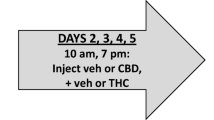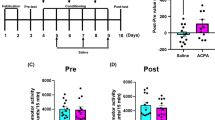Abstract
An extract of cannabis (5 and 15 mg/kg expressed as Δ9-THC) orally administered to rats caused an elevation of the nociceptive threshold (tail-flick latency and vocalization tests). Naloxone and naltrexone (blockers of μ-type opiate receptors) as well as MR 1452 (blocker of κ opiate receptors) did not prevent the antinociceptive effect of cannabis when used at the dose of 2 mg/kg SC; only a high dose (10 mg/kg SC) of these narcotic antagonists partially blocked cannabis antinociception. ICI 154, 129, an antagonist of δ-type opiate receptors, failed to prevent the cannabis-induced rise in nociceptive threshold when used at a dose of 2 mg/kg SC but produced a significant effect at 10 mg/kg SC. While the role of opiate receptors does not seem fundamental to cannabis antinociception, the clear-cut effectiveness shown by 6-hydroxydopamine (a neurotoxin which causes a degeneration of catecholamine-containing terminals) in reducing cannabis antinociception is indicative of a participation of catecholamines in the phenomenon.
Similar content being viewed by others
References
Aceto MD, Harris LS, Dewey WL, Balster RL (1975) Dependence of studies of new compounds in the rhesus monkey. Reported to the Committee on Problems of Drug Dependence of the National Academy of Sciences, Washington pp 729–772
Altaffer FB, De Balbian Wester F, Hall S, Long CJ, D'Encarnacao P (1970) A simple and inexpensive cannula technique for chemical stimulation of the brain. Physiol Behav 5:119–121
Ayhan JH (1972) Effect of 6-hydroxydopamine on morphine analgesia. Psychopharmacologia 25:183–188
Ben-Sreti MM, Sewell RDE (1982) Stereospecific inhibition of oxotremorine-induced antinociception by (+) — isomers of opioid antagonists: comparison with opioid agonists. J Pharm Pharmacol 34:501–505
Bhargava HN (1976) Inhibition of naloxone-induced withdrawal in morphine dependent mice by tetrahydrocannabinol. Eur J Pharmacol 36:259–262
Bläsig J, Reinhold K, Herz A (1973) Effect of 6-hydroxydopamine, 5, 6, dihydroxytriptamine and raphe lesions on the antinociceptive actions of morphine in rats. Psychopharmacologia 31:111–119
Bloom AS (1982) Effects of Δ9-tetrahydrocannabinol on the synthesis of dopamine and norepinephrine in mouse brain synaptosomes. J Pharmacol Exp Ther 221:97–103
Bloom AS (1984) Effect of cannabinoids on neurotransmitter receptors in the brain. In: Agurell S, Dewey WL, Willette RE (eds) The cannabinoids: chemical, pharmacologic, and therapeutic aspects. Academic Press, London, pp 575–589
Bloom AS, Dewey WL (1978) A comparison of some pharacological actions of morphine and Δ9-tetrahydrocannabinol in the mouse. Psychopharmacology 57:243–248
Bloom AS, Dewey WL, Harris LS, Brosius KK (1977) 9 Nor-9 β-hydroxyhexahydrocannabinol, a cannabinoid with potent antinociceptive activity: comparison with morphine. J Pharmacol Exp Ther 200:263–270
Bloom AS, Johnson KM, Dewey WL (1978) The effects of cannabinoids on body temperature and brain catecholamine synthesis. Res Commun Chem Path Pharmac 20:51
Bracs P, Jackson DM, Chesher GB (1975) The effect of Δ9-tetrahydrocannabinol on brain amine concentration and turnover in whole rat brain and in various regions of the brain. J Pharm Pharmacol 27:713–715
Breese GR, Traylor TD (1970) Effect of 6-hydroxydopamine on brain norepinephrine and dopamine: evidence for selective degeneration of catecholamine neurons. J Pharmacol Exp Ther 174:413–419
Buxbaum DM (1972) Analgesic activity of Δ9-tetrahydrocannabinol in the rat and mouse. Psychopharmacology 25:275–279
Chesher GB, Dahl CJ, Everingham M, Jackson DM, Marchant-Williams H, Starmer GA (1973) The effect of cannabinoids on intestinal motility and their antinociceptive effect in mice. Br J Pharmacol 49:588–594
Chesher GB (1980) Cannabis and opiate receptor. Any link? Proc Aust Physiol Pharmacol Soc 11:24–28
Cowan A, Gmerek DE (1982) In vivo studies with ICI 154, 129, a putative delta receptor antagonist. Life Sci 31:2213–2216
D'Amour FE, Smith DL (1941) A method for determining loss of pain sensation. J Pharmacol Exp Ther 72:74–79
Ferri S, Arrigo Reina R, Spadaro C, Braga P (1977) 6-Hydroxydopamine inhibits some effects of mescaline centrally administered to rabbits. Psychopharmacology 55:147–149
Ferri S, Costa G, Murari G, Panico AM, Speroni E, Arrigo Reina R (1981) Investigation on behavioral effects of an extract of Cannabis sativa in the rat. Psychopharmacology 75:144–147
Friedler G, Bhargava HN, Quock R, Way EL (1972) The effect of 6-hydroxydopamine on morphine tolerance and physical dependence. J Pharmacol Exp Ther 183:49–55
Hillard CJ, Bloom AS (1982) Δ9-Tetrahydrocannabinol-induced changes in β-adrenergic receptor binding in mouse cerebral cortex. Brain Res 235:370–377
Hine B, Friedman E, Torrelio M, Gershon S (1975) Morphine dependent rats. Blockade of precipitated abstinence by tetrahydrocannabinol. Science 187:443–445
Maitre L, Stachelin M, Bein HJ (1970) Effect of an extract of cannabis and some cannabinoids on catecholamine metabolism in rat brain and heart. Agents and Actions 1:136–143
McMillan DE, Dewey WL, Harris LS (1971) Characteristics of tetrahydrocannabinol tolerance. Ann NY Acad Sci 191:83–99
Paalzow G, Paalzow L (1975) The effects of caffeine and theophylline on nociceptive stimulation in the rat. Acta Pharmacol Toxicol 32:22–32
Reuning RH, Batra VK, Ludden TM, Jao MY, Morrison BE, McCarthy DA, Harrigan SE, Ashcraft SB, Sams RA, Bathala MS, Staubus AE, Malspeis L (1979) Plasma naltrexone kinetics after intravenous bolus administration in dogs and monkeys. J Pharm Sci 68:411–415
Shaw JS, Miller L, Turnbull MJ, Gormley JJ, Morley JS (1982) Selective antagonists at the opiate delta receptor. Life Sci 31:1259
Sofia RD, Barry H (1972) The influence of SKF 525-A on the analgesic actions of Δ9-tetrahydrocannabinol. Fed Proc 31:506
Sofia RD, Nalepa SD, Harakal JJ, Vassar HB (1973) Antiedema and analgesic properties of Δ9-tetrahydrocannabinol. J Pharmacol Exp Ther 186:646–655
Sofia RD, Vasser HB, Knobloch LC (1975) Comparative analgesic activity of various naturally occurring cannabinoids in mice and rats. Psychopharmacologia 40:285–289
Spampinato S, Candeletti S (1985) Characterization of dynorphin A-induced antinociception at spinal level. Eur J Pharmacol 110:21–30
Tulunay FC, Ayhan JH, Portoghese PS, Takemori AE (1981) Antagonism by chlornaltrexamine of some effects of Δ9-tetrahydrocannabinol in rats. Eur J Pharmacol 70:219
Wilson RS, May EL (1975) Analgesic properties of the tetrahydrocannabinols, metabolites and analogs. J Med Chem 18:700–705
Zukin RS and Zukin SR (1981) Multiple opiate receptors: emerging concepts. Life Sci 29:2681–2690
Author information
Authors and Affiliations
Rights and permissions
About this article
Cite this article
Ferri, S., Cavicchini, E., Romualdi, P. et al. Possible mediation of catecholaminergic pathways in the antinociceptive effect of an extract of Cannabis sativa L. . Psychopharmacologia 89, 244–247 (1986). https://doi.org/10.1007/BF00310637
Received:
Issue Date:
DOI: https://doi.org/10.1007/BF00310637




